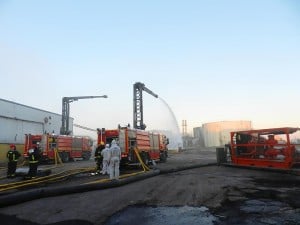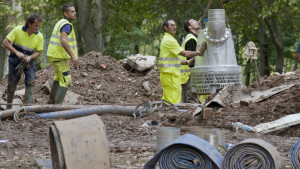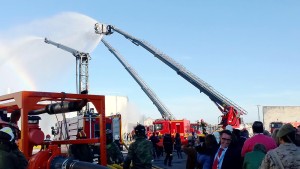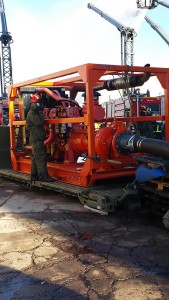Simulation helps Spain prepare for disaster
The situation is terrifying – an explosion at a petrochemical plant has killed hundreds, wounded thousands, and left an enormous crater in the ground. The explosion has also destroyed the local fire hydrant system so there is no way to put out the fire. This was the simulated event handled by the Spanish Military Emergencies Unit and Xylem earlier this year.
Though it was just a simulation, the scene of the disaster looked real enough on March 10, 2015, with fake explosions, pyrotechnics and billowing black smoke. More than 4,000 people participated in the exercise, including the Spanish Military Emergencies Unit (UME), military units from France, the U.S. and Morocco, and technicians from Xylem.
Each year, UME conducts a disaster response simulation to help Spain prepare for worst-case scenarios. This year’s five-day exercise in the city of Daimiel was the largest to date and consisted of an industrial fire at an oil plant, an oil spill, and an evacuation and cleanup.
Photo: Xylem technicians help with the disaster simulation.

“In an emergency like the simulation, the hydrant system is useless, so it is important to have an alternative system to replace it,” says Commander Maximiliano Moliterni of UME, which helped organized the exercise. “An incident like this actually happened in San Juanico, Mexico, in 1984, and more recently in Brazil last April. You need to prepare in advance and have a system that can be deployed quickly.”
Building on a successful partnership
UME first started working with Xylem in 2014 when the company was called in to help with a flooding emergency on Spain’s high-speed AVE rail line in Girona. The success of this project led UME to consider how Xylem’s emergency pumping systems could help them achieve high flow over long distances for other situations.
Photo: UME used Xylem’s Flygt BIBO pump for the flooding emergency in Girona, Spain.

After studying the locations of major petrochemical and nuclear industries in Spain, UME asked Xylem to design a portable system of pipes and pumps for emergencies. The system had to be capable of pumping 1000 m3 of water per hour at a distance of 4,000 meters, with a pressure point that could vary between 3 -14 bars, depending on which types of trucks were available.
“We started work on this simulation in October 2014,” says Miguel Almodovar, Xylem’s Dewatering Manager in Spain. “As an international supplier of pumping equipment and services, Xylem has the expertise to design solutions to handle emergencies such as flooding or major fires, while maintaining the right water pressure and flow to get the job done.”
An efficient, effective solution
Xylem proposed a portable water supply system, consisting of diesel pumps – three of Xylem’s Godwin Dri-Prime HL250 pumps and one HL160 pump – connected by a series of high-strength, flexible hoses that could easily be transported anywhere. The system included 5,000 meters of hoses, 10 inches in diameter, capable of supplying 1,000 m3 of water an hour. For the simulation, water was transported from the Azuer River four kilometers away.

“The system was very efficient and effective,” says Carlos Novillo, President of the Association of Firefighters in Spain, which also attended the simulation. “We were impressed with the ability of the equipment and system to extinguish large fires –regardless of the distance to the water and the flow and pressure required.”
During the exercise, three Xylem engineers advised the First Battalion of the UME and wore the protective uniforms of the unit.
“What caught my attention was the willingness of Xylem’s technicians to take a risk,” says Commander Maximiliano Moliterni. “There was very little time for planning during the drill, so decisions were made on the fly. Xylem’s technicians worked 24/7 during the exercise and seemed to be part of the battalion itself.”
Preparing for worst-case scenarios
Following the successful simulation, Xylem will continue to work with UME and the Association of Firefighters in Spain to develop solutions to disasters.

“We certainly expect to continue working with Xylem to improve the way we coordinate emergency responses,” says Commander Maximiliano Moliterni. “When it comes to flooding, the potential of the new system is enormous. Each Godwin Dri-Prime HL250 pump can transport more than 1000 m3 an hour, which is three times the current capacity of each battalion.”
Carlos Novillo of the firefighters association also sees the importance of Xylem’s industry expertise when planning resources for emergencies.
“From the simulation we learned that when our capacity is exceeded, no standard solution can help us,” Carlos Novillo says. “We are getting increasingly better at preventing and responding to fires, which has reduced the damage they cause. However, when the emergency is an extraordinary situation or disaster, this requires even more knowledge and expertise to control the situation and regain normalcy. Public-private partnerships like the one with Xylem should not be overlooked, since they can provide vital support when disaster strikes.”

